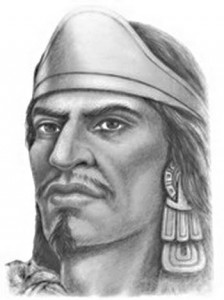 Born in 1402, before the Spanish conquest of Mexico, Nezahualcoyotl was the ruler of Texcoco and also a poet, philosopher and builder of great renown. He was raised as heir to the throne of Texcoco but when he was 15 the kingdom was overthrown and Nezahualcoyotl was forced into exile. He later returned in 1428 with an army of over 10,000 soldiers to take back the capital city and restore his family, and himself, to the throne. The battle lasted for three years but eventually saw Nezahualcoyotl as the wisest king in old Mexico and ruler of Texcoco again.
Born in 1402, before the Spanish conquest of Mexico, Nezahualcoyotl was the ruler of Texcoco and also a poet, philosopher and builder of great renown. He was raised as heir to the throne of Texcoco but when he was 15 the kingdom was overthrown and Nezahualcoyotl was forced into exile. He later returned in 1428 with an army of over 10,000 soldiers to take back the capital city and restore his family, and himself, to the throne. The battle lasted for three years but eventually saw Nezahualcoyotl as the wisest king in old Mexico and ruler of Texcoco again.
Around him he gathered all the artists and philosophers of the region, called the tlamatini, which helped to bring around what was known as the golden age. Nezahualcoyotl himself was a revered poet and he created an environment where learning and creation were put at the forefront of society, forming councils for every part of the running of the kingdom. In this way the culture is often seen as the mirror of Athens and the Ancient Greeks.
But amongst all the artists, musicians and architects of Texcoco, Nezahualcoyotl was supreme and he is seen as one of the great builders of the age before the Spanish invasion. It is also said that the king had many wives and sired over a hundred children in his lifetime.

Whilst he is known for his multiple achievements, Nezahualcoyotl was also a master poet and many of the verses from that era have been attributed to him. His work is characterized by the use of myth and symbolism and he was an influence on poets for many years after his death. Most of his verses were handed down through the ages by singing and were not actually written down until the 16th Century.
Such an example would be the flower songs written by Nezahualcoyotl which grew out of the old tradition of Nahua poetry. Unlike many of his contemporaries, he was an innovator and his style came to be copied by many other poets who followed. The flower songs all have a particular cadence and were intended to be recited or sung along with the beat of a drum and were meditations on universal concerns such as life and death and their meaning.
Although there were scores of poems from that era, the ones that have been attributed to Nezahualcoyotl include The Flight, Song of Springtime and He Alone. Over the years there has been much argument about which poems from the time should be laid at the king’s feet. He died almost 50 years before the conquest by the Spanish invasion and initially a large number were said to be written by Nezahualcoyotl though this has been revised over the years.

There is no doubt that Nezahualcoyotl had a profound effect on the cultural development of Texcoco at the time and that he enabled the intellectual life of the region to flourish under his rule. His death was recorded as occurring in 1472 which would have made him 70 years old.

